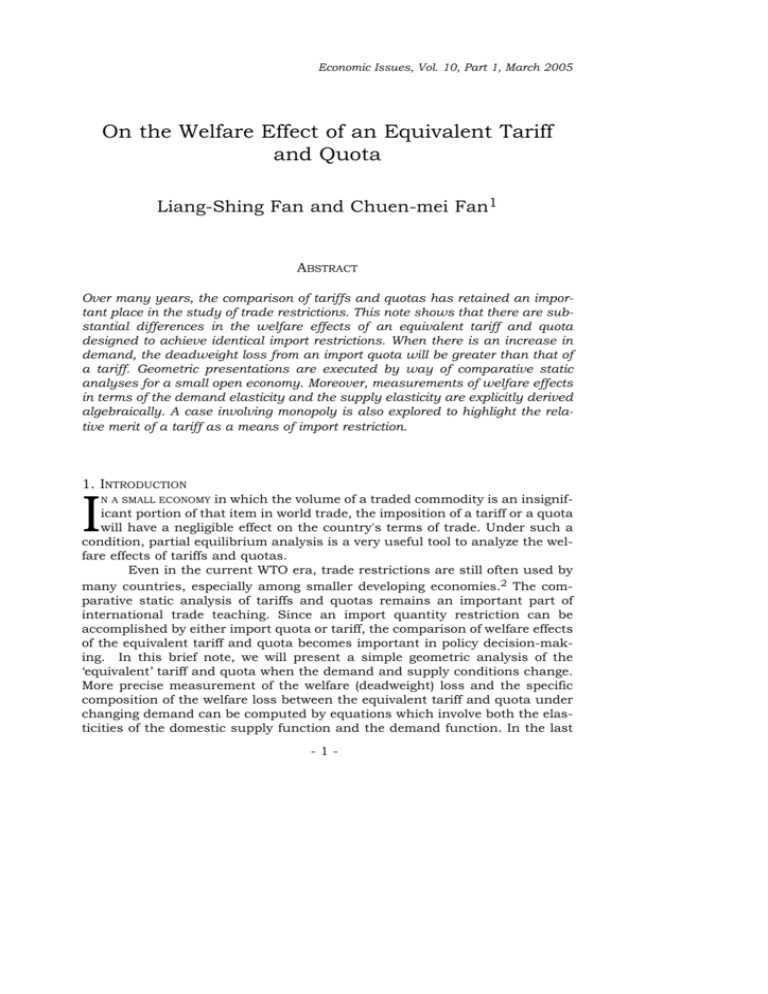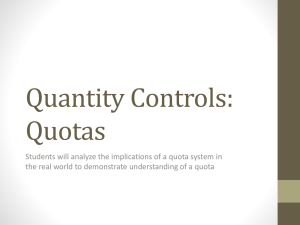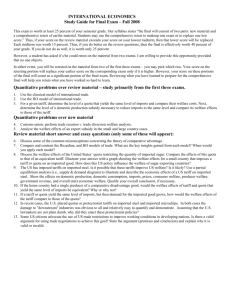On the Welfare Effect of an Equivalent Tariff and
advertisement

Economic Issues, Vol. 10, Part 1, March 2005
On the Welfare Effect of an Equivalent Tariff
and Quota
Liang-Shing Fan and Chuen-mei Fan1
ABSTRACT
Over many years, the comparison of tariffs and quotas has retained an important place in the study of trade restrictions. This note shows that there are substantial differences in the welfare effects of an equivalent tariff and quota
designed to achieve identical import restrictions. When there is an increase in
demand, the deadweight loss from an import quota will be greater than that of
a tariff. Geometric presentations are executed by way of comparative static
analyses for a small open economy. Moreover, measurements of welfare effects
in terms of the demand elasticity and the supply elasticity are explicitly derived
algebraically. A case involving monopoly is also explored to highlight the relative merit of a tariff as a means of import restriction.
1. INTRODUCTION
I
in which the volume of a traded commodity is an insignificant portion of that item in world trade, the imposition of a tariff or a quota
will have a negligible effect on the country's terms of trade. Under such a
condition, partial equilibrium analysis is a very useful tool to analyze the welfare effects of tariffs and quotas.
Even in the current WTO era, trade restrictions are still often used by
many countries, especially among smaller developing economies.2 The comparative static analysis of tariffs and quotas remains an important part of
international trade teaching. Since an import quantity restriction can be
accomplished by either import quota or tariff, the comparison of welfare effects
of the equivalent tariff and quota becomes important in policy decision-making. In this brief note, we will present a simple geometric analysis of the
‘equivalent’ tariff and quota when the demand and supply conditions change.
More precise measurement of the welfare (deadweight) loss and the specific
composition of the welfare loss between the equivalent tariff and quota under
changing demand can be computed by equations which involve both the elasticities of the domestic supply function and the demand function. In the last
N A SMALL ECONOMY
-1-
L S Fan and C-m Fan
section, some welfare effects of the equivalent tariff and quota in the presence
of monopoly will be discussed. In order to simplify the presentation, the
demand and the supply functions are assumed linear throughout and all the
shifts in demand are parallel shifts.
2. EQUIVALENT
TARIFFS AND QUOTAS
In Figure 1, given the demand (D) and the supply (S) of a traded commodity X
in a small country and a constant world price (Pw), with free trade domestic
production will be q 1 , domestic consumption will be q 2 , and there will be a sizable import of (q 2 - q 1 ). Suppose that in order to promote or protect domestic
production, a certain degree of tariff is imposed. The domestic price will be
raised to P t (the price with a tariff), and domestic production will be q 3 , domestic consumption will be q 4 , and the size of imports will be reduced to (q 4 - q 3 ).
The same result will be obtained if an import quota of (q 4 - q 3 ) is imposed.
There is an equivalence between the tariff and the quota restriction with
respect to the amount imported.
Figure 1: Demand and supply of a traded good X and the tariff
S
p
Import
Quota
Pt
a
b
c
d
Pw
D
0
q1
q3
q4
q2
q
The trade restriction creates a sizable consumer surplus loss of the
area (a + b + c + d). With the tariff, area (a) is the gain in producer surplus,
and area (c) is the tariff revenue gain for the government, thus the net welfare
loss (deadweight loss) is equal to area (b + d). However, there is a redistribu-2-
Economic Issues, Vol. 10, Part 1, March 2005
tion effect from consumers to producers (a) and to the government (c). With
the equivalent quota, similar results will prevail except that area (c) will not
automatically become government revenue unless the import licenses can be
auctioned through a well designed competitive mechanism. Quite often import
licenses are granted to producers or importers so that producers can gain area
(a + c) or the importers gain (c) as rent. In a country with rampant corruption,
licensees and government officials will most likely share this quota rent c.3
In Figure 1 the free trade price is given as Pw. With the ad valorem tariff protection the price rises to Pt = Pw·(1 + t), where t is the tariff rate in percentage form. After tabulating the changes in the consumer surplus, the producer surplus, and the government revenue the deadweight loss with tariff is
represented by two triangles, b and d, which can be expressed in the following form:
DW1 = ½ · t·Pw ·ΔqD + ½ · t·Pw ·ΔqS = ½ ·t·Pw·(ΔqD + ΔqS)
where Δqs = q3 - q1, i.e. the rise in the production of q in figure 1; ΔqD = q2 q4, i.e. the demand-side reaction; Pw·t is simply the change in the price after
the tariff is applied. Clearly, the demand and supply elasticities with respect
to the price change are:
εD = (ΔqD/q2)/(Pw · t/Pw), and εS = (ΔqS/q1)/(Pw · t/Pw), respectively.
Therefore:
ΔqD = εD·t·q2 and ΔqS = εS ·t·q1,
and
DW1 = ½ ·t2·Pw(εS q1 + εD q2 ).
(1)
It is easy to see that the graeter the supply and/or demand elasticities, the
larger the distortion will be and consequently, a greater deadweight loss the
country will incur. A detailed historical development of the (non)equivalence of
quotas and tariffs can be found in Cagatay (1985, pp. 32-34)
3. COMPARATIVE
STATICS
The discussion in section 2 above is a brief synthesis of the standard analysis
in international trade textbooks such as Krugman and Obstfeld (2003),
Salvatore (2001) and Carbaugh (2004). We have explicitly shown the roles the
demand elasticity and supply elasticity play in determining the total deadweight loss. Salvatore (2001, pp. 283-4) briefly discusses the effect of a change
in the demand for X commodity but does not fully analyze the welfare effect.
Suppose there is an increase in demand for X so that the demand curve shifts
from D1 to D2 in Figure 2. Under the tariff, the price Pt and domestic produc-3-
L S Fan and C-m Fan
tion q3 will remain unchanged, but domestic consumption will increase from
q4 to q7 and imports will increase from (q4 - q3) to (q7 - q3). The producer surplus (a) is unchanged, government tariff revenue (c) increases in proportional
to the increase in imports4 but the deadweight loss is unchanged, i.e. (b + d).
There is a sizable consumer surplus increase.
However, with a strict import quota such that (q5 - q6) = (q4 - q3), the
increase in demand will raise the price to Pq, producers will produce more at
q6 than at q3 and will gain (a') as surplus, whilst the import license owners will
reap huge profits, equal to (Pq - Pw)·(q5 - q6). Consumers’ extra loss will be
(a' + b" + c' + d") even though extra consumption means there is additional
consumer surplus. The deadweight loss will be [(b + b' + b") + (d + d' + d")],
equivalent to an additional loss of [(b' + b") + (d' + d")]. The producers’ gain is
substantial but the import license grantees will have potential quota rent as
Figure 2: Demand increase and welfare effect change
p
D2
S
D1
d″
b″
Pq
Pt
Pw
0
c′
a′
a
q1
q3
d′
c
b b′
q6
q9
-4-
q4
q5 q2
d
q7
q8
q
Economic Issues, Vol. 10, Part 1, March 2005
mentioned above.
The opportunity of securing the quota rent gives import license applicants strong incentives to bribe corrupt government officials in charge of
granting the licenses. Producers also prefer maintaining a strict import quota
for their benefit in an expanding economy.
In the case where demand decreases, Pt remains constant under the
given tariff but imports decrease. The biggest loser is the government because
of the reduction in tariff revenue, but producers continue to produce the same
output with the same producer surplus. However, if the quota is maintained,
and as long as Pq is higher than Pw, there is some quota-rent (profit) and the
amount of the quota will be imported. With a lower price, consumers will enjoy
greater consumer surplus which will come from the reduction in producer surplus and from import quota license holders’ quota rent.
When demand rises from D1 to D2 in Figure 2, the deadweight loss
remains the same as with the tariff, i.e. DW1. But with quota the excess burden (DW2) actually increases:
DW 2 = ½·Δq 2S ·ΔP + ½·Δq 2D ·ΔP = ½·ΔP[Δq 2S + Δq 2D ]
where Δq 2S = q 6 - q 1 and Δq2D = q 8 - q 5 , ΔP = Pq - Pw > Pw · t
Thus, in the case of an import quota with an increase in demand, we
obtain the following expression for the deadweight loss:
DW 2 = ½·ΔP·(ΔP/P w)[ε S q 1 + ε D q 8 ] = ½ (ΔP 2 /P w )(ε S q 1 + ε D q 8 )
(2)
This is because Δq 2S = (ε S ·ΔP·q 1 )/P w and Δq 2D = (ε D ·ΔP·q 8 )/P w .
The extra welfare loss [b' + b''+ d' + d''], in the case of a demand increase
with given import quota, can be computed as the difference between corresponding deadweight losses, i.e. DW2-DW1:
From (1), DW1 = ½ t2 Pw(εS q1 + εD q2)
= [½(Pw t)2/Pw ] (εS q1 + εD q2).
Thus, DW2 - DW1 = ½ (ΔP2/Pw) (εS q1 + εD q2) - [½ (Pw t)2/Pw] (εS q1 + εDq2)
= (1/2Pw) {εS q1 [ΔP2 - (Pwt)2] + εD [ΔP2 q8 - (Pw t)2 q2 ]}.
Since ΔP > Pwt and q8 > q2, we have DW2 > DW1. The converse holds true as
well when there is a decline in demand, which can be proven analogously.
Since the shifts in demand are frequent while changes in tariffs and quotas
are infrequent, the implication of this result is that the level of the welfare loss
can be kept stable by using a tariff rather than a quota.
4. THE
EQUIVALENT TARIFF-AND-QUOTA WITH MONOPOLY
Krugman and Obstfeld provided a brief discussion of the equivalent tariff and
quota in the presence of a monopoly in the domestic market. They simply con-5-
L S Fan and C-m Fan
cluded that under the quota the quantity produced would be less and the price
higher than the case of the equivalent tariff.
In Figure 3 below, the equivalent tariff and quota will be shown with a
decrease in the demand curve from D to Dq, with the leftward shift equal to
Figure 3: Tariff and quota in the presence of a monopoly
P
MC
Pq
a
Pt
b
c d
Q*
Pw
MRq
0
qf
qq
qt
Dq
D
q
the import quota Q*. Suppose the domestic market is initially controlled by a
monopoly firm. MRq would be the marginal revenue curve of the firm.
In the case where trade is unrestricted, the monopoly revenue is limited to
area Mf = (P w )·(q f ) because the monopolist cannot raise the price higher than
the world price Pw. Other potential importers will be able to import at the
world price by virtue of free trade. The monopolist is quite likely to be a loser
and there would be a sizable consumer surplus. The government may wish to
protect the monopoly industry (e.g. using the infant industry argument), either
by imposing an import quota or the equivalent tariff. With the tariff, Pt will prevail and the monopolist will produce at qt and total revenue will be Mt = (Pt)(q t ).
With the import quota, however, the monopolist can maximize its profit by
-6-
Economic Issues, Vol. 10, Part 1, March 2005
selling where his/her MC and MRq are equal, thus the monopoly output is lowered to qq and the price is raised to Pq. The extra consumer surplus loss is represented by area (a + b + c + d) where (a), which is equal to (P q - P t)·(q q), is the
gain for the monopolist. The parallelogram (c + d), with (c + d) = (Pq - Pt)·(Q*),
is the extra gain in quota rent for the import quota grantees. The total import
quota rent will be Q*(Pq - Pw). The size of (c + d) depends upon the elasticity of
demand D. The more inelastic the demand, i.e. the steeper the D curve, the
higher will be Pq and the increase in the quota rent will be greater. On top of
the mal-distribution effect of (c + d) from consumers to importers and (a) from
consumers to producers, there is a net deadweight loss of (b).
Let the net deadweight loss (b) = DWm. As before, Pt is the price with
tariff and Pq is the price with quota. The elasticity of demand εD =
(Δq/q t)/(ΔP/Pt ). So, Δq = (ε D ·q t ΔP)/P t. Therefore,
DWm = ½ · (ΔP) (εD·q t · ΔP/P t) = 1/2(ΔP2) (εD·q t/P t )
(3)
Thus, in the presence of monopoly, consumer welfare will be maximized only
with free trade. If for any reason imports must be restricted, a tariff should be
used rather than the equivalent import quota in order to avoid the rent-seeking (e.g. bribing) activities by the monopolist and import license applicants on
one hand and to minimize consumer welfare loss on the other.
5. CONCLUSIONS
By employing the concepts of consumer surplus, producer surplus, and deadweight loss, a comparative study of the welfare effects of an equivalent tariff
and quota is conducted in this paper. The analysis is carried out by both geometric and algebraic methods, and it provides an elementary but rigorous outcome in terms of varying demand and supply elasticities. An application
involving the presence of a domestic monopoly producer demonstrates that in
order to achieve a given degree of import restriction, a tariff is to be preferred
to a quota in order to keep welfare losses to a minimum.
Accepted for publication: 20th September 2004
ENDNOTES
1. Colorado State University. Corresponding Author: Chuen-mei.Fan@colostate.edu
2. For example, the champion of free trade — the United States government, has
recently imposed a substantial tariff on imported steel.
3. An alternative trade restriction, the voluntary export restriction (VER), can be
adopted with similar results. In this case, c will be foreign exporters’ gain and the welfare loss for the country will be area (b + c + d).
4. The increase in the tariff revenue is (Pt - Pw) (q7 - q4).
-7-
L S Fan and C-m Fan
REFERENCES
Cagatay N (1988) ‘Quota and tariffs’, in Eatwell J, Milgate M, and Newman P (eds.) The
New Palgrave, Basingstoke: Macmillan, vol. 4, 32-4.
Carbaugh R (2004) International Economics Cincinatti Oh: Thomson/South-Western,
9e.
Krugman P and Obstfeld M. (2003) International Economics: Theory and Policy, Boston:
Addison-Wesley, 6e.
Harvey R S (2002) Public Finance, London: McGraw-Hill, 6e..
Salvatore D (2001) International Economics, Englewood Cliffs: Prentice Hall. 5e.
-8-




